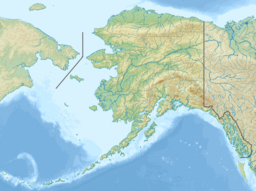
Back حوض الخليج الجليدي Arabic Glacier Bay (luuk sa Tinipong Bansa) CEB Bahía de los Glaciares Spanish Bassin de la Baie des Glaciers French グレイシャー湾 Japanese Baía dos Glaciares Portuguese Glacier Bay Serbo-Croatian
| Glacier Bay, Alaska | |
|---|---|
 Landsat map of Glacier Bay | |
 Landsat image of Glacier Bay | |
| Location | Alaska, United States |
| Coordinates | 58°42′N 136°09′W / 58.700°N 136.150°W |
| Type | Bay |
| Primary inflows | Pacific Ocean |
| Basin countries | United States and Canada |
| Max. length | 65 miles (105 km) |
| Max. width | 15 miles (24 km) |
| Surface area | 3,283,000 acres (1,329,000 ha) |
| Average depth | 800 feet (240 m) |
| Max. depth | 1,410 feet (430 m) |
Glacier Bay Basin in southeastern Alaska, in the United States, encompasses the Glacier Bay and surrounding mountains and glaciers, which was first proclaimed a U.S. National Monument on February 25, 1925, and which was later, on December 2, 1980, enlarged and designated as the Glacier Bay National Park and Preserve under the Alaska National Interest Lands Conservation Act, covering an area of 3,283,000 acres (1,329,000 hectares). In 1986, UNESCO declared an area of 57,000 acres (23,000 hectares) within a World Biosphere Reserve. This is the largest UNESCO protected biosphere in the world. In 1992, UNESCO included this area as a part of a World Heritage site, extending over an area of 24,300,000-acre (98,000 km2) which also included the Wrangell-St. Elias National Park, Kluane National Park (Canada) and Tatshenshini-Alsek Park (Canada). Part of the National Park is also designated a Wilderness area covering 2,658,000 acres (1,076,000 hectares).[1][2][3][4][5]
Current glaciers cover an area 1,375 square miles (3,560 km2) and accounts for 27% of the Park area. Up until the early 1700s the area was a large single glacier of solid ice. It has since retreated and evolved into the largest protected water area park in the world. Glacier Bay, on the Gulf of Alaska, was known as the Grand Pacific Glacier, about 4,000 feet (1,200 m) thick and around 20 miles (32 km) in width. Over the last 200 years the glaciers have retreated, exposing 65 miles (105 km) of ocean, and in this process left 20 separate other glaciers in its trail. In 1890, the name "Glacier Bay" as such was given to the bay by Captain Lester A. Beardslee of the U.S. Navy. It was first proclaimed a U.S. National Monument on February 25, 1925, by President Calvin Coolidge.[1][2][3][4][5]
The Glacier Bay has many branches, inlets, lagoons, islands, and channels that holds prospects for scientific exploration and visual treat. Thus, the area is popular as a cruise ship destination during summer season. However, there are restrictions imposed by the National Park Service on the numbers of vessels that can operate in a day to 2 cruise ships, 3 tour boats, 6 charter vessels, and 25 private vessels. The bay received an average of about 443,975 recreational visitors annually from 2012 to 2021, with 89,768 visitors in 2021.[6] According to a tourism score, the best time to visit Glacier Bay National Park and Preserve is from mid July to mid August for activities in warm weather.
- ^ a b Michigan living, Volume 66. Automobile Club of Michigan. 1983. p. 38. Retrieved 2010-08-15.
- ^ a b "Fauna & Flora of Glacier Bay National Park". Glacier Bay Organization. Archived from the original on March 5, 2009. Retrieved 2010-08-15.
- ^ a b "Glacier Bay National Park and Preserve". Encyclopædia Britannica.
- ^ a b "2010 Fact Sheet" (PDF). National Park Service: US Department of the Interior. Archived from the original (PDF) on 2012-01-15. Retrieved 2010-08-15.
- ^ a b "Glacier Bay National Park & Preserve". Glacier Bay National Park & Preserve. Archived from the original on 2010-09-17. Retrieved 2010-08-15.
- ^ "National Park Service Visitor Use Statistics". NPS Stats. National Park Service. Retrieved 8 June 2022.
